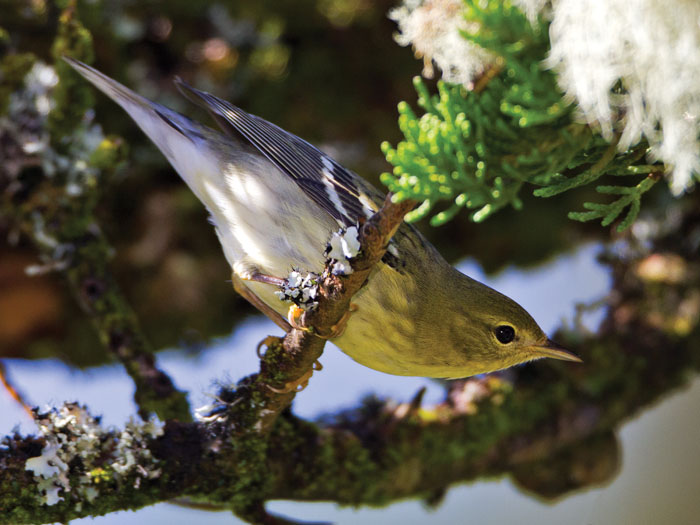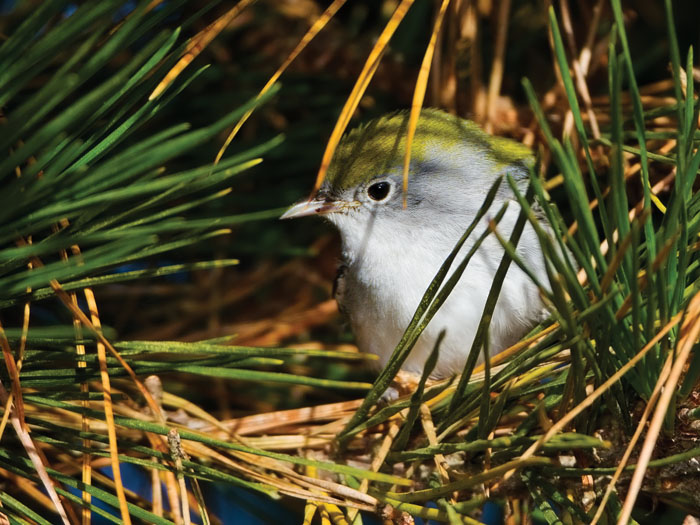On a Saturday in late September, fall bird migration is in full swing and, with winds light and southerly, Bay Area birders are heading to outer Point Reyes. At B Ranch, five or six cars are parked under a line of gnarled old Monterey cypresses. Standing shoulder to shoulder along the east side of the road, the birders stare intently into the treetops through their binoculars. Local birding Listservs are reporting an uncommon Philadelphia vireo, a species that breeds in the young deciduous forests of northernmost New England and Canada. In the fall, Philadelphia vireos migrate to Central America, traveling southeasterly to the Atlantic coast and Florida or across the Gulf of Mexico, so this bird’s appearance at Point Reyes is highly unusual, even extraordinary. Hence the gaggle of birders seeking a glimpse of the rarity.
A bit of movement on the back side of a cypress prompts the birders to hurry up the slope and around to the other side of the trees. After several minutes, a white-crowned sparrow gently shakes a twig, drawing the birders’ attention. Then a small green-backed bird flits across the top of the tree only to dive out of sight again—not enough of a view to make an identification. Finally, the bird—the vireo—hops to the end of a scraggly, upturned branch and sits there quietly for several minutes. Its bright yellow breast and black and white markings around the eyes glow softly in the autumn light. “In plain view!” shout a couple of the birders; the others exclaim, “Oh my God, it’s gorgeous!” and “A bright male, awesome!”
After lingering briefly, the birders move on. The Philadelphia vireo is not the only rarity spotted in the vicinity today. They head off to scour a handful of other sites for blackpoll warblers, a prairie warbler, an American redstart, and an eastern phoebe, all species that hail from the northeast and north-central sections of the United States and Canada yet reportedly seen on Point Reyes.

These out-of-range birds are known as vagrants: Individual birds that, during migration, veer far off the normal route for their species and are, essentially, lost. A worldwide phenomenon, vagrancy was first noticed along the California coast in the late 1800s. In 1967, researchers at Southeast Farallon Island began to systematically trap and band land birds, creating a long-running record of unusual birds on the island. As birding became more popular in the 1970s and 1980s, records of the rare sightings accumulated from Point Reyes and other local “vagrant traps”—coastal sites with high concentrations of vagrant birds. Today, with birders instantaneously sharing notable sightings on the Internet, many more birders are making spur-of-the-moment trips to Point Reyes in search of these locally unusual birds.
Fall vagrancy at Point Reyes follows a predictable pattern. A trickle of vagrant birds begins in August; hundreds more appear from mid-September through October, and a few continue to be found into late November. It is easiest to spot vagrants on days with southerly or easterly winds or little wind at all.
The greatest number of vagrants turn up on nearshore islands, promontories, and headlands. Flying overnight in a southwesterly direction, from their northern breeding grounds these migrants often overshoot the shoreline and at dawn are forced to seek rest and cover on the closest visible land.
Banding records from Southeast Farallon Island reveal that 4 percent of all fall migrants caught there are vagrants, compared to only 0.5 percent at a Big Sur banding station. High numbers of vagrants are also found at Outer Point Reyes, where the land juts 12 miles into the Pacific and is in close proximity to the Farallones. Many of these birds find shelter in the shrubby vegetation, willow clumps, and Monterey cypresses at the lighthouse and on Outer Point ranches in the National Seashore.
Certain species of wood warblers reliably appear every fall and in roughly the same proportions. American redstarts and palm, blackpoll, prairie, and chestnut-sided warblers are some of the most “common” vagrants. Most of these individuals are hatch-year birds and thus lack the stunning breeding plumages for which the wood warblers are admired, although adults can also be found, showing their striking and colorful patterns.

Scientists have long debated the causes of vagrancy. An early theory, now discounted, was that these birds are disoriented: Their flight lacks any pattern or consistent direction and is in effect random. Researchers now believe that instead of being disoriented, vagrant migrating birds are “misoriented”—consistently oriented, but in the wrong direction.
In fact, the theory of “mirror-image misorientation” neatly accounts for the appearance of birds from the northern U.S. and Canada ending up at Point Reyes. Based on experiments with vagrant blackpoll warblers on Southeast Farallon Island, Institute for Bird Populations ornithologist Dave DeSante posits that these individual birds have a defective sense of direction, causing them to confuse left and right in a precise manner. Although fall migration generally takes northern birds south for the winter, over the millennia, many of the vagrant species expanded their ranges westward from the Northeast while still retaining the habit of migrating down the Atlantic coast on their way to the tropics. The result of mirror-image misorientation is that, if a species’ normal route is, say, 40 degrees east of due south, the misoriented individuals orient 40 degrees west of due south and keep going, eventually reaching the coast of California.
But mirror-image misorientation does not affect birds in a uniform manner; otherwise, the tendency would have been eliminated by natural selection. Rather, experts have concluded, it works in tandem with wind drift, a second critical influence on vagrancy in California. If northeasterly winds occur just when a misoriented bird sets off, this individual will be blown in a southwesterly direction and, rather than making a course correction, the bird simply continues.

Scientists have noted that warblers, sparrows, finches and tanagers — all songbirds with 9 primary wing feathers — comprise a higher proportion of Point Reyes vagrants than songbirds having 10 primaries, such as flycatchers, vireos, and thrushes. Although there are many factors at work, one possible explanation is that, because the 9-primaried species are more recently evolved than birds having 10 primaries, they have had less time to evolve migratory habits and strong navigational skills, including left-right discrimination.
Many vagrants from the East that appear on the California coast are thought to rest, refuel, and then continue southwest over the ocean, eventually becoming exhausted and drowning at sea. Others may remain on the mainland but are not known to survive for long in unfamiliar habitat, let alone find their way farther south to their species’ normal wintering areas. On the other hand, a few of these species, in particular palm warblers, white-throated sparrows, and swamp sparrows, have established wintering populations in Northern California. In spring, some may actually migrate in a northeasterly direction back to their normal breeding grounds. In this way, the tendency for mirror-image misorientation—at least for these species—is passed on to the next generation.





